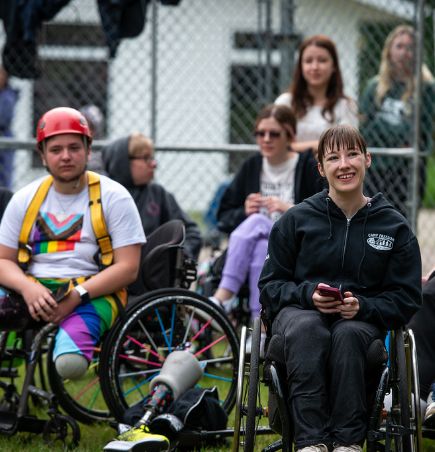About SBHANA
The Spina Bifida and Hydrocephalus Association of Northern Alberta (SBHANA) is a dedicated organization committed to providing support, advocacy, and resources for individuals and families affected by spina bifida and hydrocephalus. Our primary mission is to enhance the quality of life for individuals living with spina bifida and hydrocephalus, as well as to provide comprehensive support for their families. Through a combination of community engagement, advocacy, and educational initiatives, we aim to empower our members and raise awareness about these conditions.
At SBHANA, we are more than an organization; we are a lifeline for those navigating the challenges associated with these conditions. Our mission is to provide unwavering support, foster awareness, and advocate for the rights of our community members.
Advocacy
Our advocacy efforts aim to influence positive changes in policies and attitudes.
Education
We aim to dispel misconceptions, promote inclusivity, and empower both our community and the public with knowledge.
Support
We believe in the strength of community, and our gatherings provide opportunities for mutual understanding and empathy.
What Sets us Apart
Supportive Community
SBHANA fosters a caring and inclusive community where individuals facing the challenges of spina bifida and hydrocephalus can connect, share experiences, and find a network of understanding and support.
Advocacy and Awareness
We actively advocate for the rights and well-being of our community, working towards increased awareness, understanding, and inclusivity within the broader society. Our advocacy efforts aim to influence positive changes in policies and attitudes.
Inclusive Community
We pride ourselves on building a diverse and inclusive community where individuals and families feel understood, valued, and empowered. Our events and programs are designed to foster connections and camaraderie.
Provide Emotional Support
Facing the challenges associated with spina bifida and hydrocephalus can be daunting. Our support groups and counseling programs offer a platform for individuals and families to share their journeys, seek guidance, and find solace in a compassionate and understanding environment.
Promote Education and Awareness
Through workshops, seminars, and educational programs, SBHANA strives to increase awareness and understanding of spina bifida and hydrocephalus. We aim to dispel misconceptions, promote inclusivity, and empower both our community and the public with knowledge.
Empowerment Through Events
From support groups to recreational activities, our events provide opportunities for personal growth, skill-building, and the joy of shared experiences.
Foster Community Connection Through Programming and Events
Our events create a welcoming space for individuals to connect, share experiences, and build supportive relationships. We believe in the strength of community, and our gatherings provide opportunities for mutual understanding and empathy.

Our Mission
To improve the quality of life for people affected by spina bifida and hydrocephalus through advocacy, education, and support.
Our Vision
People and the community affected by spina bifida and hydrocephalus are engaged, informed, and empowered through a vibrant network facilitated by our leading and innovative organization.

Our History
In 1972, a compassionate group of parents joined forces to create a supportive community, sharing experiences and navigating the challenges of raising children affected by spina bifida and/or hydrocephalus. Recognizing the need for structured assistance, they initiated monthly support meetings, held in collaboration with the spina bifida clinic at the Glenrose Hospital, starting from December 1975 until May 1981.
On June 25, 1981, a significant milestone was reached with the official incorporation of the Northern Alberta Spina Bifida Association. Over the years, the association underwent transformative growth, adapting to the evolving needs of the community it served. In 1999, a pivotal moment marked a name change to reflect a broader scope, becoming the Spina Bifida and Hydrocephalus Association of Northern Alberta (SBHANA).
Throughout its history, SBHANA has remained dedicated to providing unwavering support to individuals affected by spina bifida and hydrocephalus. The organization has thrived as a beacon of understanding, advocacy, and community, offering valuable resources, support networks, and educational initiatives. SBHANA’s commitment to the well-being of its community members has solidified its position as a dynamic and successful organization, continually evolving to meet the diverse needs of those it serves.

About The Daisy
The SBHANA’s symbol is the daisy, which represents the challenges of spina bifida and hydrocephalus.
The HEART of the flower represents the brain, which in the case of persons living with spina bifida, is often affected by hydrocephalus. The daisy’s PETALS are cloven, thereby representing the various lesions caused by spina bifida and hydrocephalus. The daisy’s LEAF AND STEM are irregular and depict the unusual form of the spinal cord and backbone of a person born with spina bifida. The BEAUTY of the flower reflects the beauty of people with spina bifida and hydrocephalus who, in spite of their challenges, live happy and productive lives.
Our People
SBHANA is supported by a dedicated and passionate group of people who are committed to making a positive impact in our community. Comprised of individuals from diverse backgrounds and professions, this dynamic team shares a common goal: to improve the quality of life for people affected by spina bifida and hydrocephalus through advocacy, education, and support.